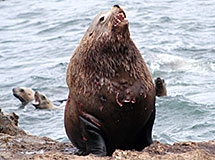Where Can I See Sea Lions in Oregon
Callorhinus ursinus The Northern fur seal is the smallest member of the family in Oregon. The flippers are nearly twice as big equally those of a comparably-sized private of any other species of otariid. The ears are cylindrical and the auditory meatus is covered with wax to prevent entry of h2o. The pelage consists of coarse baby-sit hairs and an exceedingly thick underfur that serves equally waterproof insulation. Adult males are dark grayness or brown dorsally and reddish brown ventrally; a grayish greatcoat covers the neck and shoulders. Adult females are grayish brown dorsally and reddish brown ventrally. The Northern fur seal is restricted largely to the waters and some insular areas of the North Pacific region. In Oregon, information technology occurs generally along the northern declension. They typically feed at night and during crepuscular hours because their prey migrates toward the surface at dark. They generally rest and slumber on the surface during the solar day, although they may feed if prey is available. Photo past Don Henise, Flickr
Northern fur seal
Eumetopias jubatus The Steller (or Northern) sea lion is the largest member of the family Otariidae. Among developed females and subadult males, the upper torso is slim, whereas in adult males it is heavy and muscular. The head is bearlike with a moderate pace between muzzle and forehead. The rear flippers are relatively small and can exist turned beneath the trunk for travel on land. The pelage is light buff to reddish brown, slightly darker in the chest and abdomen. Overall the pelage appears darker when moisture. However, beneath the h2o it appears white, whereas the California sea lion appears black. In surveys along the Oregon Coast, Steller bounding main lions were observed aground at 10 sites extending from the Due south Jetty at the mouth of the Columbia River in Clatsop County, south to Rogue Reef in Curry County. The Steller sea king of beasts is gregarious, forming big groups on traditional rookeries and resting areas; at sea information technology may class rafts of several hundred individuals. The Stellar sea lion is an Oregon Conservation Strategy Species in the Nearshore ecoregion. Photo from ODFW
Steller ocean lion
Zalophus californianus The California sea lion is the mid-sized Oregon otriid. The body is slender and tapering, the flippers are relatively small, and the rear flippers can be rotated below the body for moving on land. The short, course pelage lacks dense underfur; when dry, it unremarkably is chocolate brown, but individuals with light-tan pelage are known to occur. The pelage appears black when moisture. In older males, the pate is tan. The occurrence of the California sea lion forth the Oregon coast is seasonal. The primary areas where it comes ashore are Cascade Caput, Tillamook County; Cape Argo, Coos County; and Rouge Reef and Orford Reef in Curry County, only it also occurs in Yaquina Bay and at Bounding main Lion Caves in Lane County and on Simpson Reef, Coos County. Many enter rivers to feed and some individuals migrate far up the larger rivers. These sea lions are superb swimmers and defined. They can stay nether water for as long as xx minutes. Photo by Patti Berry
California bounding main king of beasts
Mirounga angustirostris The Northern elephant seal is the largest pinniped carnivore that occurs forth the North Pacific coast. The flippers are relatively small, the rear ones directed posteriorly. Its near distinctive feature is the elongated tubular proboscis with a deep transverse cleft among developed males. This proboscis can exist inflated and directed into the open mouth to produce vocalizations. As well among males, the neck and chest lose near of their hair and the pare becomes crude and thickened at puberty. The adult pelage consists of course grayish or brownish hairs without any underfur. During the molt, non simply is the pelage shed, but the entire cornified epidermis sloughs off in large patches, creating a mottled advent. In Oregon, individual elephant seals reportedly were sited aground south of Bandon and at Simpson Reef, in Coos County. In add-on, they take been found at Seal Stone, Depot Bay, and Newport in Lincoln County, and at the mouth of the Columbia River, Clatsop County. Except for the time spent on the rookery during the convenance flavor and a month or then ashore while undergoing the molt, the Northern elephant seal is truly a pelagic mammal. They accept set records for the deepest dives recorded for any mammal. The Northern elephant seal is an Oregon Conservation Strategy Species in the Nearshore ecoregion. Photograph by Frank Schulenburg
Northern elephant seal
Phoca vitulina The body of the Pacific harbor seal is plump but tapers to small rear flippers permanently extended posteriorly. The caput is large and rounded, the optics are large, the limbs are short, and the nostrils sit down dorsally on the cage. The nostrils can exist closed when this seal dives. The tongue is notched at the tip. The pelage consists of long overhairs that overlay brusque underhairs. Markings are extremely variable, but in general the pelage is grey or chocolate-brown gray with numerous pocket-sized spots of blackness that may coagulate to form splotches. Pacific harbor seals take been observed aground at 32 sites along the Oregon coast and in estuaries from the Columbia River to Hunter'southward Island, Back-scratch County. About are found forth the northern coast. They ordinarily come up ashore on estuarine mud flats, sandy beaches, rocky headlands and offshore rocks and islands. These seals are solitary in the water, merely commonly gather in small groups of mixed sexes and ages when they come ashore. Some seals movement cracking distances whereas others move little or not at all. The Pacific harbor seal is an Oregon Conservation Strategy Species in the Nearshore ecoregion. Photo by Kathy Munsel, ODFW
Pacific harbor seal
Source: https://myodfw.com/wildlife-viewing/species/seals-and-sea-lions
0 Response to "Where Can I See Sea Lions in Oregon"
Post a Comment